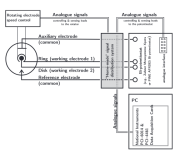
Apparatus and methods for using a rotating ring–disk electrode with potentiodynamic control of both working electrodes
The paper authored by
S. Vesztergom,
N. Kovács,
M. Ujvári and
G.G. Láng
is published in Technisches Messen (2017, vol. 84, pp. 683–696).
Abstract:
When studying electrochemical processes, one of the most widely used methods of determining the reaction pathway is an electrochemical assay of products using a rotating ring–disk electrode (RRDE). An RRDE tip consists of two electron conducting parts: a centrally located disk and a ring around it. When brought into contact with an electrolyte solution, the disk and the ring both form electrodes, the potentials of which can be independently controlled by a bi-potentiostat. When the tip is rotated, reactants from the solution arrive at the disk where they undergo an electrode reaction (oxidation or reduction) at a given rate, depending on the rotation speed. The formed products leave the disk surface and due to forced convection make their way towards the ring electrode where they can undergo another electrode reaction and can thus be detected. Normally, one applies potentiostatic control to at least one of the electrodes when carrying out an RRDE experiment; albeit the simultaneous potentiodynamic perturbation of the electrodes offers an increased applicability range. This paper presents the construction of a measuring system capable for the “bi-potentiodynamic” perturbation of two working electrodes, and demonstrates the use of such methods in case of a few chosen example systems.
